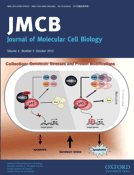
FASEB JOURNAL
Scope & Guideline
Pioneering Insights in Biochemistry, Genetics, and Medicine
Introduction
Aims and Scopes
- Molecular and Cellular Biology:
Research focusing on the molecular mechanisms of cellular processes, including gene expression, protein interactions, and cellular signaling pathways. - Physiology and Pathophysiology:
Studies examining the physiological functions of organisms and the alterations that occur in various disease states. - Developmental Biology:
Investigations into the processes of development from embryogenesis to adult forms, emphasizing the genetic and environmental factors influencing these processes. - Metabolism and Endocrinology:
Research exploring metabolic pathways, energy homeostasis, and the hormonal regulation of physiological functions. - Immunology and Inflammation:
Studies investigating the immune response, the mechanisms of inflammation, and their implications for diseases such as cancer and autoimmune disorders. - Neuroscience:
Research related to the nervous system, including studies of neural signaling, neurodegenerative diseases, and the effects of drugs on neural function. - Translational Research:
Research aimed at bridging laboratory findings with clinical applications, focusing on the development of new therapies and diagnostic tools. - Microbiology and Infectious Diseases:
Studies addressing the mechanisms of microbial pathogenesis, host-pathogen interactions, and the impact of microbiota on health. - Biotechnology and Therapeutics:
Research focused on the development of biotechnological applications and therapeutic strategies based on biological insights.
Trending and Emerging
- Microbiome Research:
An increasing focus on the role of the gut microbiome in health and disease, including its impact on metabolism, immunity, and neurological functions. - Exosome Biology:
Growing interest in the role of exosomes in intercellular communication, particularly in cancer progression, immune modulation, and tissue regeneration. - Gene Editing and CRISPR Technologies:
Research utilizing CRISPR and other gene-editing technologies is expanding, particularly in the context of therapeutic applications and functional genomics. - Metabolomics and Lipidomics:
Emerging studies in metabolomics and lipidomics are providing insights into metabolic disorders, obesity, and the biochemical pathways involved in health and disease. - Immunotherapy and Cancer Biology:
A surge in research focusing on immunotherapeutic strategies for cancer treatment, including the mechanisms of immune evasion and the development of novel immunomodulatory agents. - Artificial Intelligence in Biomedical Research:
The integration of artificial intelligence and machine learning in analyzing complex biological data is becoming a significant trend, facilitating advancements in personalized medicine. - Neuroinflammation and Neurodegeneration:
Increased research on the role of neuroinflammation in neurodegenerative diseases, exploring potential therapeutic targets and intervention strategies. - Regenerative Medicine and Stem Cell Research:
Growing interest in regenerative medicine, particularly the use of stem cells and biomaterials in tissue engineering and repair.
Declining or Waning
- Traditional Pharmacology:
Research centered on conventional drug development and pharmacological studies has seen a decline, possibly due to a shift towards precision medicine and targeted therapies. - Basic Animal Models:
The use of traditional animal models for basic biological studies may be waning as researchers increasingly explore alternative models, including organ-on-a-chip systems and humanized models. - Genetic Studies in Isolated Populations:
Research focusing on genetic variations in isolated or specific populations appears to be less frequent, as there is a broader trend towards global genomics and population-wide studies. - Single Pathway Studies:
Research that focuses on individual signaling pathways without considering broader network interactions is decreasing, as there is a growing emphasis on systems biology and integrative approaches.
Similar Journals

JOURNAL OF BIOSCIENCES
Connecting Researchers to the Heart of BiosciencesJOURNAL OF BIOSCIENCES, published by the Indian Academy of Sciences, has established itself as a pioneering platform in the fields of biosciences, encompassing diverse research areas such as agricultural and biological sciences, biochemistry, genetics, molecular biology, and medicine. With an impressive trajectory since its inception in 1979, the journal has achieved notable recognition, securing a Q1 ranking in Agricultural and Biological Sciences and maintaining its place in the top quartiles for Biochemistry and Medicine as of 2023. With Scopus rankings placing it at #32 in General Agricultural and Biological Sciences and #65 in General Biochemistry, Genetics, and Molecular Biology, the journal reaches the 85th and 70th percentiles respectively, reflecting its impact and relevance in current scientific discourse. Although it does not offer open access, the JOURNAL OF BIOSCIENCES remains crucial for researchers, professionals, and students dedicated to advancing knowledge and innovation within the biosciences, providing a vibrant forum for high-quality research and comprehensive reviews.

Journal of Molecular Cell Biology
Connecting the world of genetics and cellular research.The Journal of Molecular Cell Biology, published by Oxford University Press, is a leading platform for groundbreaking research in the fields of cell biology, genetics, and molecular biology. With an impact factor that places it in the Q1 and Q2 quartiles across key academic categories, this journal has become an essential resource for researchers and professionals committed to advancing our understanding of cellular mechanisms and genetic processes. Since becoming Open Access in 2019, it has enhanced the accessibility of high-quality research, fostering collaboration and knowledge sharing within the scientific community. The journal's Scopus rankings reflect its significant impact in the field, particularly in genetics and molecular biology, ranking within the top percentiles. With a convergence of research spanning from 2009 to 2024, the Journal of Molecular Cell Biology remains at the forefront of innovative discoveries and critical discussions, making it a vital resource for students, academics, and industry experts alike.

CELLULAR AND MOLECULAR LIFE SCIENCES
Leading the Charge in Open Access Life Sciences PublishingCELLULAR AND MOLECULAR LIFE SCIENCES, published by SPRINGER BASEL AG, stands as a premier journal dedicated to advancing the field of cellular and molecular biology. With an impressive 2023 impact factor reflected in its Q1 rankings across key categories—including Cell Biology, Molecular Biology, and Pharmacology—it serves as a critical platform for researchers aiming to disseminate high-quality findings in these dynamic fields. Operated under an open access framework, the journal allows broader accessibility to groundbreaking research, fostering collaboration amongst scientists globally. Based in Switzerland, CELLULAR AND MOLECULAR LIFE SCIENCES has been at the forefront of scientific publishing since 1952, adapting to contemporary scientific challenges and trends, ultimately shaping the future of life sciences.

Frontiers in Bioscience-Landmark
Exploring the Depths of Molecular InnovationFrontiers in Bioscience-Landmark is a prestigious journal published by IMR PRESS that focuses on a diverse array of topics within the fields of biochemistry, genetics, molecular biology, immunology, and microbiology. With the ISSN 2768-6701 and E-ISSN 2768-6698, this journal has carved a significant niche since its inception in 1996, making its mark in contributions to the scientific community all the way through to 2024. Having achieved a respectable Q2 cohort rank in multiple categories, including biochemistry and immunology, it stands out for its impactful research, evidenced by its current Scopus rankings which highlight it as a vital resource for ongoing studies and advancements in the biosciences. Despite not being open access, the journal ensures that readers have access to high-quality research articles that are peer-reviewed and designed to foster academic discourse. The importance of Frontiers in Bioscience-Landmark lies in its commitment to disseminating innovative findings that can significantly enhance our understanding of biological sciences, making it an essential read for researchers, professionals, and students alike.

JOURNAL OF BIOENERGETICS AND BIOMEMBRANES
Exploring the Dynamics of Life at the Cellular LevelJOURNAL OF BIOENERGETICS AND BIOMEMBRANES, published by SPRINGER/PLENUM PUBLISHERS, is a leading journal dedicated to the study of bioenergetics and biomembranes, covering essential topics such as cellular energy transformation and membrane dynamics. Since its inception in 1976, the journal has developed a robust reputation within the scientific community, currently holding a Q3 ranking in Cell Biology and a Q2 ranking in Physiology for 2023. Boasting a prestigious Scopus Rank in both Biochemistry and Physiology, it serves as a crucial platform for disseminating pioneering research findings. With its commitment to quality and innovation, the journal plays a significant role in advancing our understanding of the fundamental processes that underlie life at the cellular level. Although it does not offer open access options, the journal remains accessible through universities and research institutions, ensuring that vital research is widely shared among scholars, professionals, and students alike. The JOURNAL OF BIOENERGETICS AND BIOMEMBRANES is essential for anyone seeking to contribute to or stay informed about developments in this dynamic field.

BIOCHEMICAL AND BIOPHYSICAL RESEARCH COMMUNICATIONS
Unveiling the complexities of molecular life.BIOCHEMICAL AND BIOPHYSICAL RESEARCH COMMUNICATIONS, published by Academic Press Inc Elsevier Science, stands as a leading periodical in the fields of biochemistry, biophysics, cell biology, and molecular biology. With an ISSN of 0006-291X and an E-ISSN of 1090-2104, this esteemed journal has been a pivotal platform for the dissemination of groundbreaking research since its inception in 1959, continuing to publish influential findings through at least 2024. It holds a commendable Q2 ranking in Biochemistry and Q1 status in Biophysics as of 2023, reflecting its high impact and relevance in the field, supported by its strong Scopus rankings—ranking #43 in Biophysics and maintaining a presence in the top quartiles of several related categories. Although it is not an open-access journal, it provides critical insights and essential data that cater to researchers, professionals, and students keen on advancing their understanding of complex biochemical and biophysical processes. Its significant contributions to the scientific community underscore the importance of this journal as a reference point for innovative research and collaborative discourse.

Open Biology
Pioneering interdisciplinary research for a better tomorrow.Open Biology is a prestigious, interdisciplinary journal published by the Royal Society that has been paving the way in the fields of Biochemistry, Genetics and Molecular Biology, Immunology, and Neuroscience since its inception in 2011. Catering to a global audience of researchers, professionals, and students, Open Biology operates under an open access model, facilitating the unrestricted dissemination of high-quality research findings. With a current impact factor that positions its categories in the top quartile (Q1) and impressive Scopus rankings—evidencing its influence and reach—this journal serves as a vital platform for innovators and scientific inquiries aimed at advancing our understanding of life sciences. The journal's commitment to publishing cutting-edge research makes it an essential resource for those at the forefront of scientific exploration.

FEBS Open Bio
Championing transparency in the world of molecular science.FEBS Open Bio is a leading open-access journal published by Wiley, dedicated to advancing our understanding of biochemistry, genetics, and molecular biology. Since its inception in 2011, this journal has provided a robust platform for researchers to share their findings with a wider audience, ensuring the dissemination of high-quality scientific knowledge. With an impact factor reflecting its stature in its field, FEBS Open Bio is ranked #77 out of 221 in general biochemistry, genetics, and molecular biology, placing it in the 65th percentile among its peers. This journal serves as an essential resource for professionals, researchers, and students alike, fostering collaboration and innovation within the scientific community. The commitment to open access not only enhances visibility but also promotes transparency in research, making it a vital contributor to the ongoing dialogue in biochemical and molecular biological sciences. For those looking to stay at the forefront of research developments, FEBS Open Bio is a key publication addressing the latest trends and discoveries in the field.

BIOSCIENCE REPORTS
Fostering Innovation in Biological ResearchBIOSCIENCE REPORTS, published by Portland Press Ltd, is a prestigious journal dedicated to advancing the fields of biochemistry, biophysics, cell biology, and molecular biology. Founded in 1981, the journal has established itself as a vital resource for researchers and professionals, boasting a significant impact factor and high rankings within its categories, including Q2 in Biochemistry and Q1 in Biophysics as of 2023. The journal’s commitment to high-quality, peer-reviewed research ensures that it remains an influential platform for the dissemination of cutting-edge scientific findings. While it operates under a traditional subscription model, it offers various access options to accommodate the needs of the scientific community. With ongoing publication through 2024, BIOSCIENCE REPORTS continues to play a crucial role in shaping discussions in the life sciences and fostering innovative research in biology.

POSTEPY BIOLOGII KOMORKI
Connecting Scholars Through Cellular InsightsPOSTĘPY BIOLOGII KOMÓRKI is a pivotal journal in the field of cell biology, published by the renowned Polskie Towarzystwo Anatomiczne. Since its inception, this journal has been dedicated to advancing scientific knowledge through the dissemination of high-quality research articles, reviews, and original studies focused on cellular structure and function. Although POSTĘPY BIOLOGII KOMÓRKI does not currently operate as an open-access journal, it remains a significant resource for researchers and professionals alike, contributing to critical discussions and findings in the biological sciences. The journal has undergone coverage discontinuation in Scopus, yet it continues to serve as an essential platform in Poland for scholarly exchange in cellular and anatomical research. Situated at the Centrum Medyczne Kształcenia Podyplomowego in Warsaw, it aims to bridge gaps in understanding and nurture academic growth among students and professionals in the biological sciences.